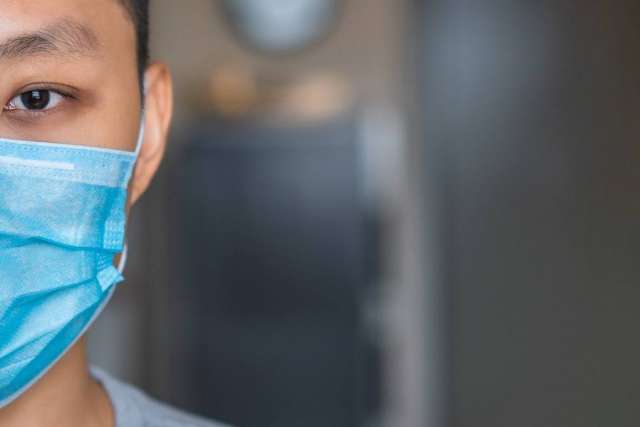“For the first time, I’m having to really think about what it means to be Asian American in the U.S., and even in Los Angeles,” says Alice Kuo, MD, chief of Medicine-Pediatrics at UCLA and professor of Internal Medicine and Pediatrics at the David Geffen School of Medicine at UCLA.
Kuo is one of the medical professionals who shared experiences with racism, sexism and discrimination during the “Department of Medicine Community Conversation.” The event was organized by the Department of Medicine Office of Equity, Diversity and Inclusion at UCLA to address anti-Asian racism in America and provide a safe space for the medical community to talk openly.
The virtual conversation among faculty, staff, trainees and students took place March 16, 2021, just hours after news broke that eight people – six of Asian descent – were killed in Atlanta. This attack was the latest of several recent acts of violence toward Asians across the country: In Los Angeles, a woman was robbed and assaulted, an elderly man was physically assaulted in San Francisco and died as a result of his injuries, and in New York, a man’s face was slashed with a box cutter on the subway.
During the event, Kuo said she had experienced, “quite a bit of discrimination” as a junior faculty member in the early 2000s, such as being told by an older male supervisor to “act more like an Asian woman.”
“I didn't know what to make of that comment then,” she says now. “I think that many Asians have been the recipient of those types of remarks or comments and may or may not have perceived them as racist at the time.”
She says anti-Asian racism is sometimes harder to identify, “because it can be more subtle.” But the emergence of COVID-19 removed any subtlety and accelerated outright discrimination against Asian Americans.
In late January 2020, Google searches for “Wuhan Virus” and “Chinese Virus” began to spike. A month later, the World Health Organization released guidelines cautioning against the use of stigmatizing language in reference to COVID-19. By early March, however, U.S. leaders such as former-President Donald Trump, former director of the Central Intelligence Agency Mike Pompeo and U.S. Rep. Paul Gosar were using the terms in media interviews. News articles using these terms increased by 800% on March 9, 2020. One week later, anti-Asian sentiments on Twitter rose by 17,000% among hashtags using "China virus.”
Between March 2020 and Feb. 2021, nearly 3,800 hate incidents were reported to the Stop Asian American and Pacific Islander (AAPI) Hate Reporting Center, a platform launched by the Asian Pacific Planning and Policy Council (A3PCON), Chinese for Affirmative Action (CAA), and the Asian American Studies Department of San Francisco State University.
“I think a mistake we make is thinking racism is only about hate crimes, but it's way bigger than that,” says Gilbert Gee, PhD, professor in the Department of Community Health Sciences at the Fielding School of Public Health at UCLA and author of several research articles on anti-Asian racism.
“These conversations happen periodically, because we’ve never solved the problem of racism in our society,” he says. “The conversations we have – the stereotypes we have – are just part of a broader structure of inequality that just has never left us.
“Much like latent infections and things like tuberculosis, it gets sequestered and kind of surfaces at moments of stress.”
Myth of the model minority
The complicated history of life in the U.S. for Asian Americans and Pacific Islanders dates back to the mid-19th century. Laws such as the 1882 Chinese Exclusion Act, the lesser-known Page Law of 1875 (which prohibited Chinese women from entering the U.S.), the 1917 Immigration Act and 1924 National Origins act were used to deny immigration and citizenship opportunities to Asians, exacerbating the ongoing dismissal of their civil rights.
In 1965, non-restrictive quotas allowed immigrants, largely Asian families, into the country. Additionally, the U.S. welcomed Asian engineers and scientists during the Cold War to help further military technology. The general sentiment toward Asian immigrants began to shift.
In 1966, the myth of the model minority, the stereotype that all Asian Americans are wealthy, smart, polite and docile, emerged from a story in the New York Times written by William Petersen, a sociologist at UC Berkeley, said Manjusha Kulkarni, executive director of the Asian Pacific Policy and Planning Council, lecturer on Asian American Studies at UCLA, and speaker at the UCLA Health Equity and Justice Action Series Confronting and Addressing Anti-Asian Racism, Harassment and Violence webinar.
“He said Asian Americans were well off or doing better economically than African Americans … and that African Americans were a problem because they were demanding their civil rights, whereas Asian Americans were stereotyped as silent,” Kulkarni said.
The UCLA Health system-wide webinar moderated by Julian McNeil, the program manager of the Anti-Racism Roadmap at the David Geffen School of Medicine, featured conversations among Kulkarni; Karen Umemoto, the Helen and Morgan Chu Chair, Asian American Studies Center at UCLA and professor in the departments of Urban Planning and Asian American Studies at UCLA; and Brandon Ito, assistant clinical professor of Psychiatry at UCLA.
What people have to consider about the model minority myth, Dr. Ito said, is that the Asian American and Pacific Islander community is comprised of a very diverse and vast number of different ethnicities, with different experiences and immigration patterns.
“One of the ways that this myth can be damaging is that it presumes that everybody is the same and functioning well, which we know is not true,” he said. “We know that the Asian American community has one of the biggest wealth disparity gaps within different ethnic communities.”
Disaggregating the data
With a racial group comprising nearly 43 distinct ethnic groups, it’s no surprise there are differences in occupations, cultural practices, pay and health.
A study co-authored by Dr. Gee notes that AAPIs are overrepresented at both ends of the economic scale, with Japanese and Filipino Americans having lower poverty rates than white Americans, while Hmong, Khmer, Laotian, and Vietnamese Americans have higher poverty rates.
While more than 2 million AAPIs work in jobs that put them at greater risk for COVID-19, “there's sort of a baseline difference in various health conditions that can, in part, play a role in COVID-19 severity,” Dr. Gee says. “Take diabetes, which is relatively high amongst Filipinos and Asian Indians compared to other groups like Japanese Americans.”
Other COVID-19 comorbidities include hypertension, obesity, diabetes and cardiovascular disease. Among AAPIs, nearly 20% of native Hawaiians and Pacific Islanders have heart disease, and 6.9% have coronary artery disease. South Asians have been identified as being high risk for cardiovascular disease.
Although certain communities bore the brunt of COVID-19, data aggregation erased the alarming rate at which some Asian American Pacific Islander groups were infected, says Jeffrey Hsu, MD, PhD, cardiologist at UCLA and Dr. Gee’s co-author.
“When you look at the aggregate data, it looks like the outcomes for the AAPI community aren't too dissimilar from the white community,” he says. “But in studies done in California, you see a stark difference between some of the subgroups, particularly from lower socioeconomic subgroups like the Filipino and Vietnamese populations. They have significantly worse outcomes compared to white people.”
Research show that within California, Pacific Islanders are dying from COVID-19 at a rate that is fourfold their population share, the most disproportionate rate of any population within the state.
Disparities vary by location and no two states follow similar reporting structures. In South Carolina and Florida, Asians get classified as “other” in publicly available platforms. In California, Asians make up 14.5% of the population, but account for 13% of COVID-19-related deaths. Pacific Islanders make up 0.1% of the population, but represent 1.6% of deaths.
“If you’re unaware that there are differences in outcomes, you're not going to devote your time and attention to public health resources for these communities,” says Dr. Hsu. “If you just looked at the AAPI data overall, you would think they’re doing well, and wouldn’t focus any attention on them, but once you realize that the Vietnamese, Filipino and Pacific Islander communities are doing more poorly, then you need to understand why they're doing more poorly and what you can do to really target these communities.”
But while COVID-19 affects AAPI subgroups to different degrees, Dr. Gee says, everyone’s physical and mental health are profoundly affected by incidents of discrimination and racism both overt and subtle.
“There's a large body of research that shows that those mundane everyday experiences of microaggressions can contribute to stress and allostatic load – wear and tear on the body,” he says. “We believe that this contributes to things like inflammation, and that, in turn, can lead to all kinds of problems physically and mentally.
“Just witnessing or hearing discrimination can have bystander effects that are very stressful and traumatizing.”
How to help
Drs. Hsu and Gee say there are a number of ways health care providers can help address health disparities and discrimination.
“One of the most important things is when somebody says they encountered discrimination, simply take their word for it,” Dr. Gee says. “Because Asian Americans are seen as a model minority, their concerns are oftentimes dismissed. People say things like, ‘you don't have it as bad as other groups,’ or ‘you’re really smart and rich.’
“That can be true for some people but that’s not true for everybody.”
Dr. Hsu provides three cultural competency tools for mitigating disparities. The first centers around language. “For example, if you don't speak the patient’s language, or no one on the team speaks the language, ensure that you're using an interpreter rather than trying to get by on incomplete communication.”
Second, make an effort to understand cultural differences and dynamics. For instance, in some cultures, it may be important to include a patient’s other family members in the care plan.
Lastly, Dr. Hsu says, understand the patient’s cultural relationship to their overall health and identity. For example, “you shouldn’t use blanket recommendations on how to eat healthier, but instead provide advice that the patient could reasonably achieve.”
Dr. Hsu says in both times of crisis and as a routine practice, health care systems should proactively reach out to communities that are being disproportionately burdened by discrimination and disease.
“Let them know they will be welcomed here and we understand their culture,” he says, “that we have people here who are part of their culture and we will make every attempt to ensure that they can seek care safely.”
Dr. Gee encourages all people to speak out when possible.
“One of the tools of structural racism is to keep people in place, and part of the way of keeping people in place is to demand silence and to be complicit in the face of the oppressions that we have,” he says. “If people don't talk about it, they feel like they're not entitled to their experiences – and that is part of how the racial hierarchy keeps reinventing itself.
“So, it's really important for us to speak up when we feel like we can.”
Learn more about enhancing allyship and cultural humility by visiting the HEDI website.




